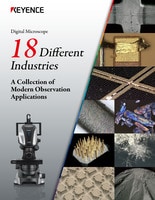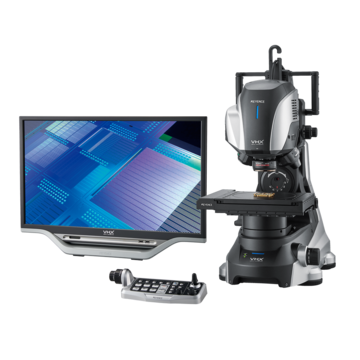Digital Microscopes
Elemental Analysis with Digital Microscopes Using LIBS (Laser Induced Breakdown Spectroscopy)
LIBS (Laser Induced Breakdown Spectroscopy) is an elemental analysis method that uses a pulse laser to identify elemental components.

This section provides an overview of LIBS and introduces examples of elemental analysis using a digital microscope.
Get detailed information on our products by downloading our catalog.
View Catalog

What Is LIBS (Laser Induced Breakdown Spectroscopy)?
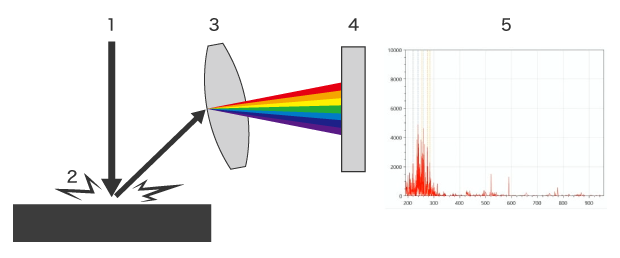
LIBS is an abbreviation for Laser Induced Breakdown Spectroscopy. It is an elemental analysis method in which a pulse laser irradiates the sample. The wavelengths of the generated plasma are split by a spectrometer, and then the light intensity of each wavelength is analyzed to identify the contained elemental components.
This analysis method has also been used during NASA’s investigations on Mars and allows for vacuum-free elemental analysis.
-
1The pulse laser irradiates the sample.
-
2Light is emitted by the plasma on the sample surface.
-
3The light emitted by the plasma is split into wavelengths by a spectrometer.
-
4The detector collects the intensity of each wavelength.
-
5Spectra are obtained from intensity data, and the ratios of contained elements are calculated.
We’re here to provide you with more details.
Reach out today!

Advantages of Using LIBS
LIBS offers the following advantages.
- Elements can be detected starting with light elements such as hydrogen (H) and lithium (Li).
- No vacuum required.
- No pre-processing (cutting, polishing, conductivity treatment, etc.) required.
- Vacuum-free usage is possible, eliminating limitations on sample size.
- The spot diameter of approximately 10 µm (0.000394″) allows for analysis of microscopic samples.
- Liquids can be analyzed.
- Elemental analysis can be performed deeper into the material by irradiating the sample with multiple pulses in sequence (using the drilling function).
We’re here to provide you with more details.
Reach out today!

Examples of Elemental Analysis Using a Digital Microscope
This section introduces the latest examples of elemental analysis using KEYENCE’s VHX Series 4K Digital Microscope and EA-300 Series Laser-based Elemental Analyzer.
Examples in the battery industry
Lithium battery negative electrode analysis

The target does not have to be melted down to detect the light element lithium.
Battery fluid leakage and corrosion analysis

Eliminating the need to perform pre-processing saves a lot of time. Both liquids and powders can be analyzed, and the inclusion of color information results in reports that are visually easier to understand.
Examples in the plating industry
Plating cross section elemental analysis

The short analysis time allows for an increased number of analyses.
Foreign particle analysis inside metal plating

The drilling function allows for analysis of foreign particles inside plating.
Plating film thickness evaluation

The drilling function allows for evaluation of the plating film thickness. This not only enables thickness management but also makes it possible to check whether the correct materials have been used.
We’re here to provide you with more details.
Reach out today!

Examples in the food manufacturing and pharmaceutical industries
Crystal component inspection (salt crystals)

Crystals that cannot be identified just with observation can be identified with elemental analysis.
Tablet foreign particle analysis

The drilling function allows for analysis of foreign particles inside tablets, eliminating the hassle of removing foreign particles.
Foreign particle analysis in manufacturing processes

The detection of Ag (silver) identifies the target as a silver dental crown. Also, the detection of molybdenum indicates that the target is from dental material. The intrusion path can be identified in a short time, making it possible to prevent reoccurrences of the same problem.
Examples in the electronic components and semiconductor industries
Whisker analysis

The target can be identified as a whisker or as a fibrous foreign particle.
Analysis of the peeling of probe pin plating

The peeling of the plating on the tip of a probe pin can be analyzed.
Analysis of stains on gold plating

Adhesion can be checked for in the case of gold-plated chromium. Seepage from underneath can be checked for in the case of gold-plated nickel.
We’re here to provide you with more details.
Reach out today!

Examples in the automotive industry
Engine part foreign particle analysis
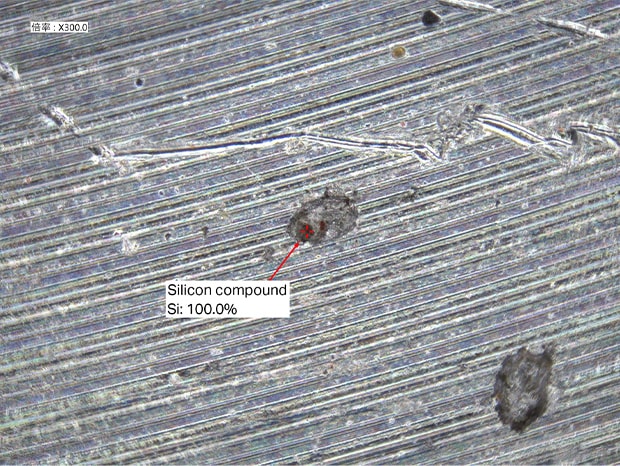
Foreign particles inside die cast parts can be analyzed.
Chip analysis
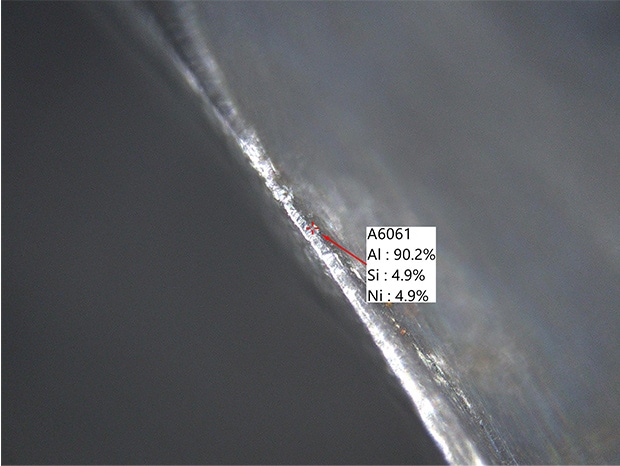
Subjecting a chip to elemental analysis can identify its product.
Checking for peeling of chromium plating on injector pins

The analysis indicates whether the surface plating has peeled off, whether the base material is visible, and whether components from the paired part have adhered to the plating. Free-angle analysis is possible even for three-dimensional targets.
Gear defect analysis after sintering
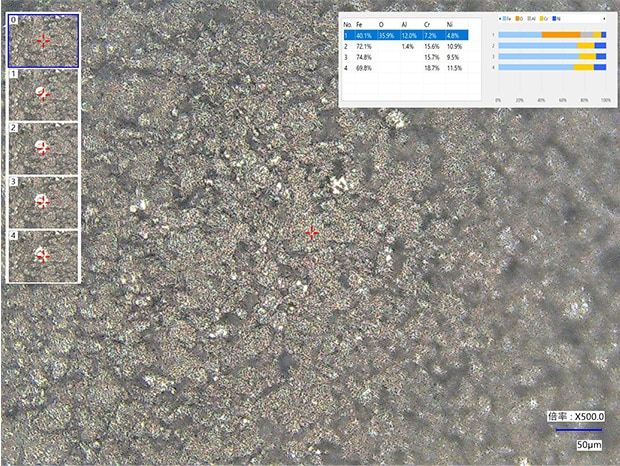
In response to a defect in which the product became black, the analysis showed that the cause was alumina adhering to the surface, not the carbonization of the surface.
Examples in the chemical industry
Foreign particle analysis of vibration-proof rubber
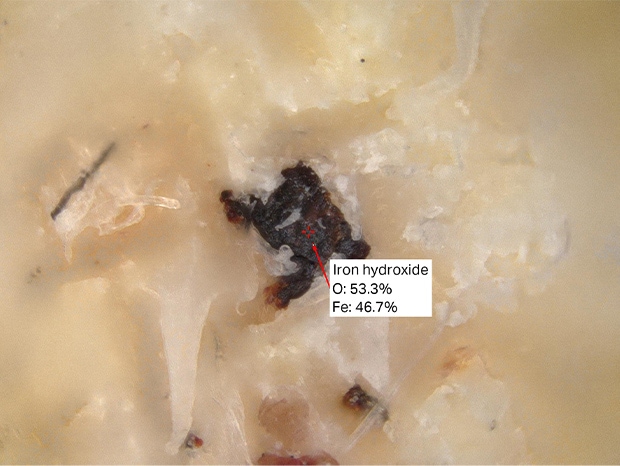
The foreign particles can be identified as organic or inorganic. Inorganic foreign particles affect the performance of the rubber.
Coating film defect evaluation
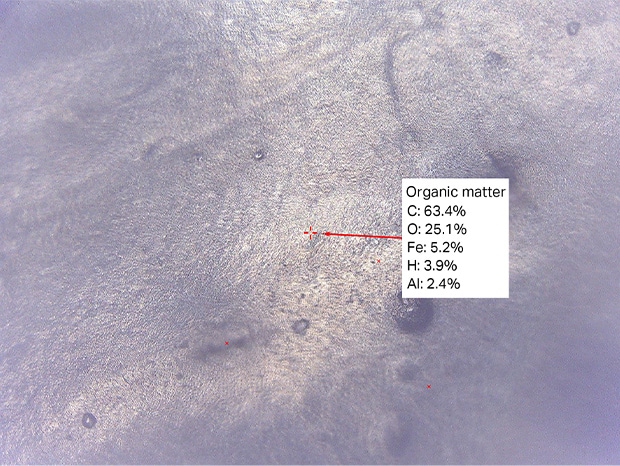
When the film is not the normal color, it can be compared against a good product with an analysis of the components inside the film, allowing for the identification of the cause of the defect and for the provision of instructions to the supplier.
Identification of paint adhered to products

Elemental analysis can identify at which part of the manufacturing process the paint was added. Not only can the target be evaluated as organic or inorganic, but the color information can also be identified. Even large products 1 m or more in size can be analyzed as-is.
Foreign particle analysis of resin coating
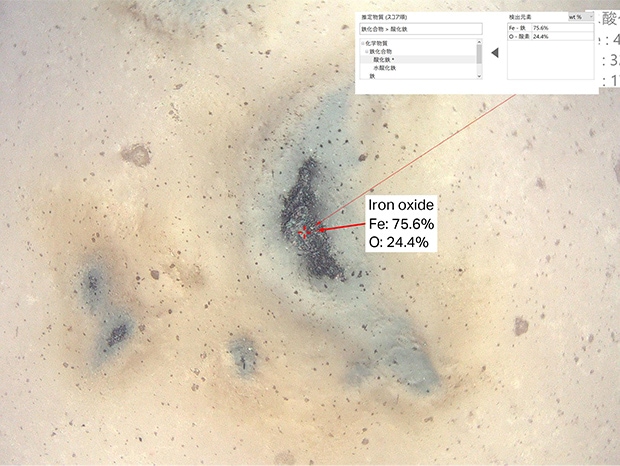
Analysis is possible without having to cut the target and remove the foreign particles.
We’re here to provide you with more details.
Reach out today!

Examples in the metals industry
Inspection of the amount of chemicals remaining during polishing with a diamond grinding bit
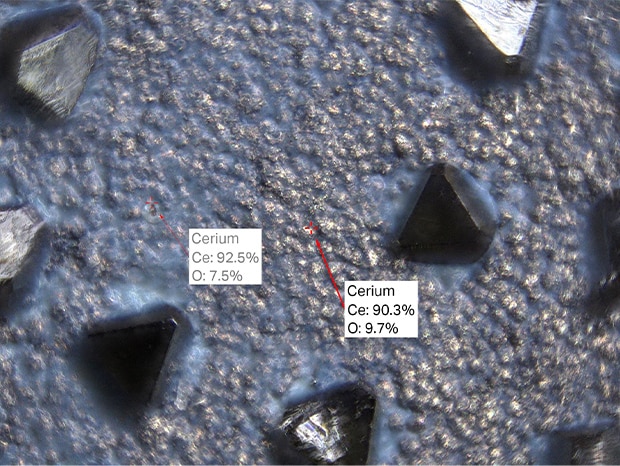
Analysis can be performed in a non-destructive manner with no deposition, so it is easy to inspect the amount of cleaning agent (fluorine chemical) remaining. Also, the drilling function can be used to check for unevenness in the cerium coating on the surface.
Presence inspection of coating material on tool blade tips
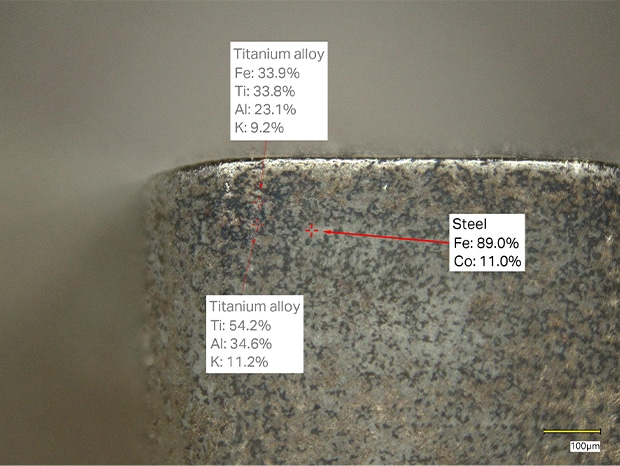
The coating material (titanium or chromium) is peeled off during repolishing of tools. If some of the old coat remains on the tool, the new coat cannot be applied. Elemental analysis allows for pinpoint detection of scattered pieces of coating material.
Tool blade tip coating layer analysis
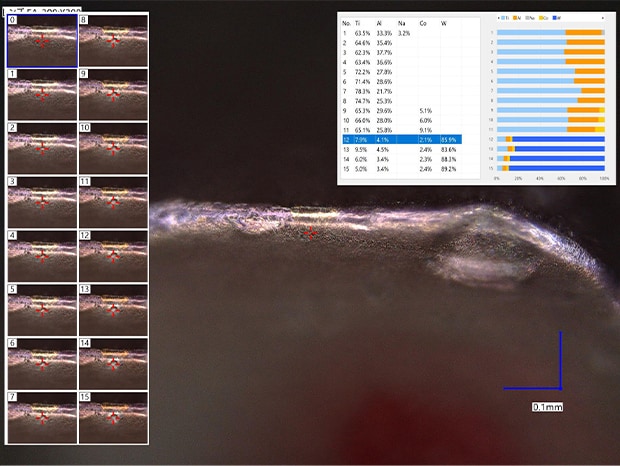
The coating layer material and base material can be analyzed with the drilling function. Conventionally, the target had to be cut and polished before it could analyzed. The introduction of the EA-300 has reduced the time and effort that this analysis requires. The durability and service life of a tool blade tip differs depending on the coating layer, but these differences can also be analyzed.
Joint rust analysis

Pinpoint analysis of discolored locations is possible, allowing them to be evaluated as rust stains adhered to the surface or as rust generated from inside the stainless steel.
Examples in the film and sheet industry
Analysis of foreign particles on TAC film
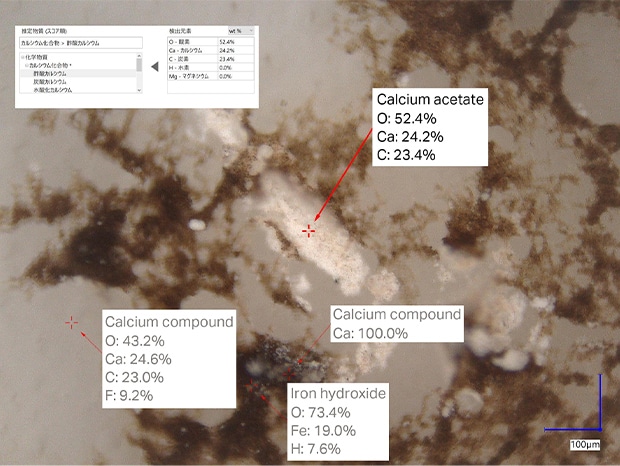
The parts with different colors were judged to be organic materials and were identified as rust.
Analysis of foreign particles in film
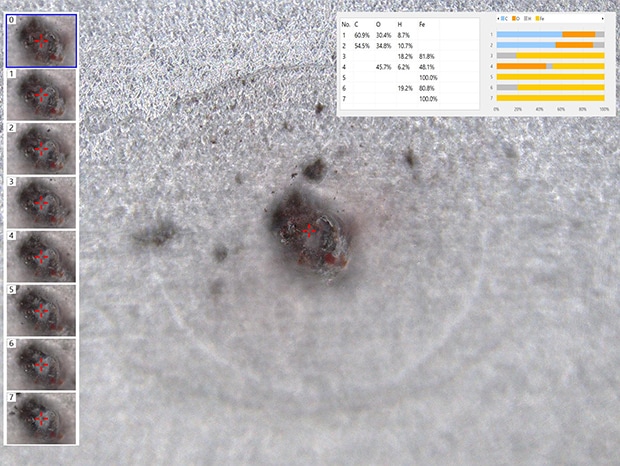
It is difficult to remove microscopic foreign particles from a film, so it was not possible to analyze these particles. However, the drilling function of the EA-300 enables this analysis.
Analysis of foreign particles on printer film
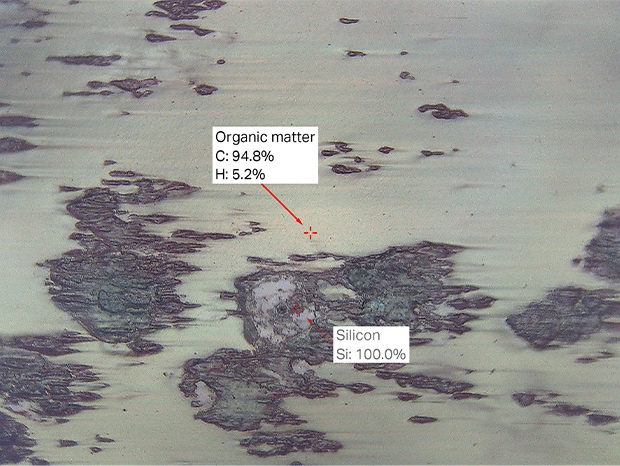
Large targets are too big to load on an SEM, but the EA-300 can analyze these targets as-is and with no vacuum required. The detection of calcium indicates that the particles are from paper. The detection of silicon indicates that the particles are from toner.
Detection of pigments on the film used in gravure plate making

The detection of organic materials and titanium confirms that pigments are on the film surface.
We’re here to provide you with more details.
Reach out today!

Strengths of KEYENCE’s EA-300 Series Laser-based Elemental Analyzer
Elemental Analysis with the VHX Series Digital Microscope

Step 1: Magnified observation
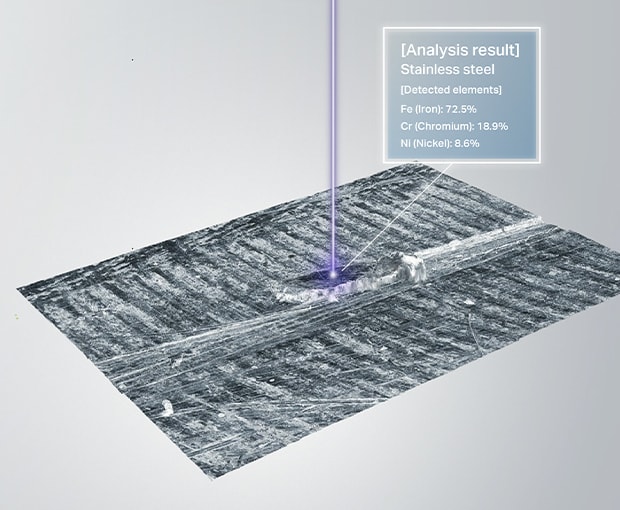
Step 2: One-click elemental analysis
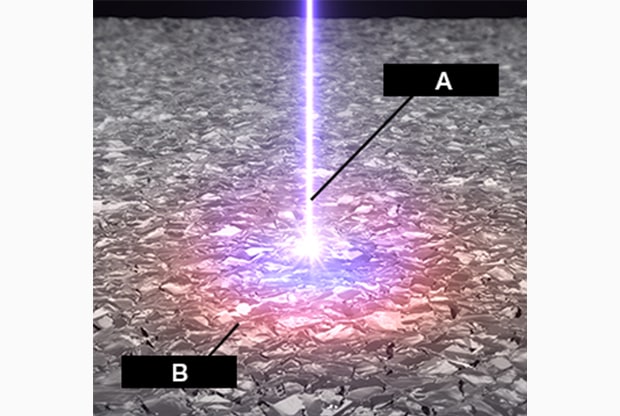
A: Nanosecond laser pulse, B: Plasma emission
Ultra-high-speed LIBS analysis
Take advantage of vacuum-free elemental analysis during observation of the target placed on the stage. There is no need for cutting, conductivity treatment, or use of a vacuum.
The elemental analyzer uses laser induced breakdown spectroscopy with a highly safe Class 1 laser. The laser turns the target surface into plasma while a broadband (deep UV to near-infrared) high-resolution spectrometer detects the emitted light color. The microscope optics are situated along the same axis to visualize the target area.

AI-Suggest WORLD’S FIRST
Materials are identified easily through elemental analysis.
An integrated database includes thousands of elemental patterns, allowing the device to instantly determine not only the detected elements but also suggest the material name. Material data is organized hierarchically to make it easy to check the specific name, generic name, and description. The database can also be used to collect historical in-house analysis results for reference when similar foreign particles are detected. This makes it possible for anyone to identify a material instantly with no advanced technical skill required.
Get detailed information on our products by downloading our catalog.
View Catalog


